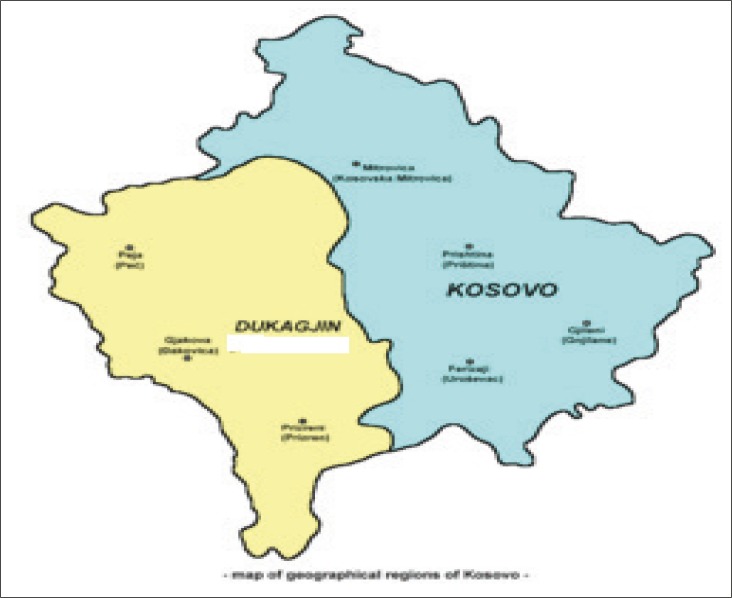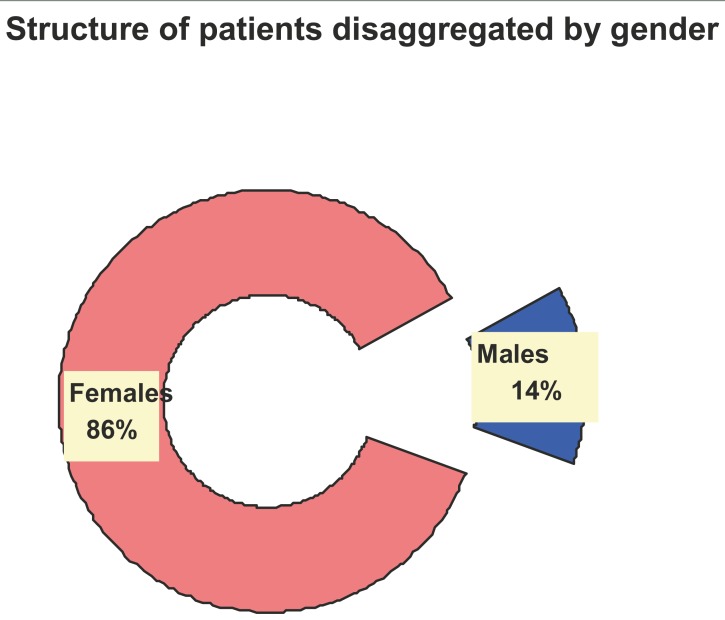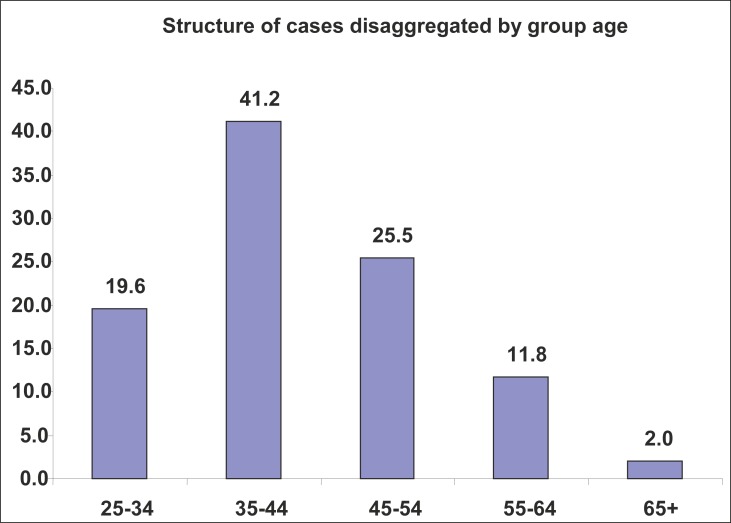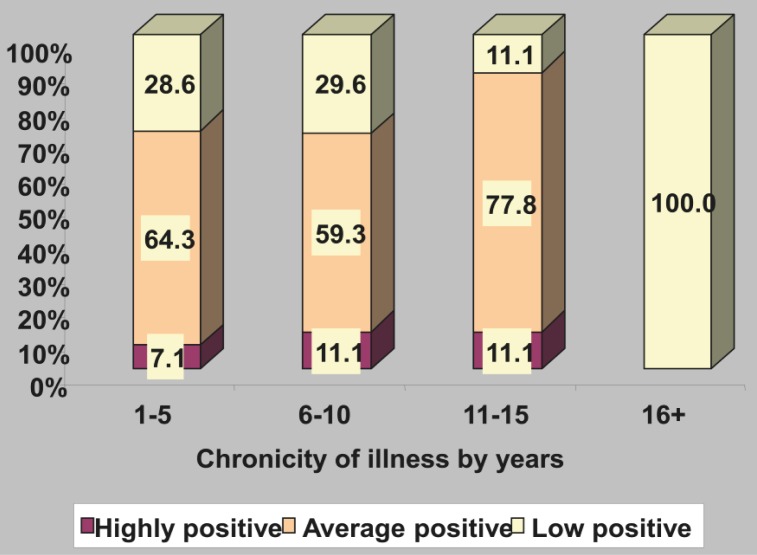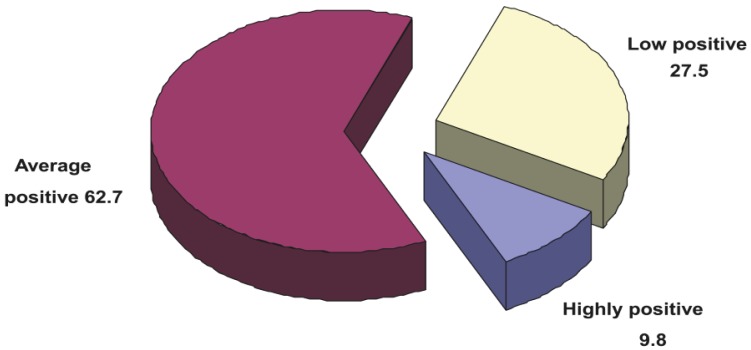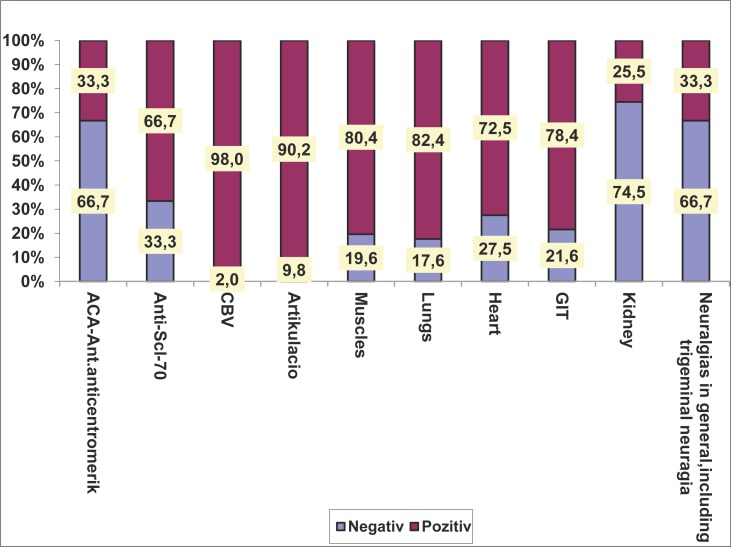Abstract
Introduction:
Progressive systemic sclerosis (PSS) is an inflammatory disease of connective tissue, with onset as edema that continues with fibrosis, induration, and skin atrophy, followed by attacks on the joints, internal organs, and secondary proliferation of connective tissue.
Purpose:
To research in which residence locations and among which group age is the most frequent incidence, prevalence and clinical manifestations of systemic sclerosis in Dukagjini Plain which is inhabited by 698450 resident citizens.
Material and methods:
51 patients with progressive systemic sclerosis were studied, out them 44 were females (86.3%) and 7 males (13.7%) respectively, during the period from 2005 to 2010. Their illness was active from 18 to 60 months in accordance with EUSTAR criteria. They are of different age, median age is 44.2 ±10.1. Their diagnose is determined based on revised ACR criteria. Prevalence of patients with PSS was 14.61/100.000, while the incidence was 2.8/100.000, whereas CI (Confidence interval) or limit of accuracy was 95%.
Results:
Largest number of patients per 100.000 citizens has Istog municipality which has the largest number of patients with PSS. It is followed by Mamusha and Rahovec municipalities. The largest examined group age is 35-44 year old, 41.2% respectively.
Conclusion:
Additional studies are necessary to carry out in order to find the reasons of asymmetrical distribution of patients with systemic sclerosis in the municipalities of Dukagjini Plain.
Key words: systemic sclerosis, incidence, prevalence, Dukagjini Plain, clinical features.
1. INTRODUCTION
Progressive systemic sclerosis (PSS) is an inflammatory disease of connective tissue, with onset as edema that continues with fibrosis, induration, and skin atrophy, followed by attacks on the joints, internal organs, and secondary proliferation of connective tissue (1).
Other attacked organs besides the skin are: esophagus, lungs, heart, muscles, etc. Scleroderma is presentation of this systemic disease in the skin. Changes in the blood vessels begin with proliferation in intima, edema of media, activation of platelets and fibroblasts, formation of their deposits that cause obliteration of blood vessel and consecutive ischemia of a tissue supplied by damaged blood vessels (2).
First clinical sign is edema, skin thickening on the proximal and metacarpo-phalangeal articulations, and Raynaud phenomenon is almost always positive. This condition is relatively rare. Epidemiological surveys indicate 10-16 new cases per 1 million people (3).
Frequency of this condition is 3.5 – 4 times higher among females than in males, while in reproductive phase the frequency is even higher. Prevalence of scleroderma is 10 – 20 persons in 100.000 people, whereas incidence is 1 – 3 persons in 100.000 people per year. The role of genetic factors still remains unclear, though there are families with high number of members who suffer from PPS (4).
Numerous researches have indicated connection of systemic sclerosis with HLA-DR1, HLA-DR3 and HLA-DR5 among cases with manifestations in the skin and internal organs, whereas in pulmonary hypertony is present HLA-DR 6. (5).
Etiology of illness is unknown. Metabolic and vascular alterations of collagen and derangement of immune factors are blamed for the onset of illness. Immunological and cyto-pathological studies have confirmed that cells of the blood vessel intima are not proliferating, on contrary we have a significant increase of collagen. Thus, basic pathogenetic changes are large proliferation of connective tissue – fibrogenesis, and excessive activation of fibroblasts with their depositions (6).
Both vascular and immunological theories were unable to explain the whole etiology, but however they should be taken into consideration (7).
Despite all efforts, PSS remains the least researched systemic inflammatory disease so far. Lots of doubts yet remain whether systemic sclerosis is an autoimmune disease due to little findings in serological markers, particularly of specific antibodies (8).
Electronic search in internet (Yahoo) and search of medical literature published to date in the medical database (Pub Med) didn’t give any research related to the incidence, prevalence and clinical manifestation of systemic sclerosis in the Dukagjini Plain.
Dukagjini Plain is administrative-territorial part of the Republic of Kosova. Its size is 4326 km2, makes 39.7 % of total size of Kosova, composed of 3 large regions (Prizren, Peja and Gjakova), it has 12 municipalities and a total of 545 settlements. The last census held in 2011 revealed 698450 resident citizens, males – 349476, females – 348974, all Caucasoid race. (9).
2. CLINICAL MANIFESTATIONS OF SYSTEMIC SCLEROSIS
Clinical manifestation of systemic sclerosis includes a range of changes from skin to internal organs and the whole body. Raynaud Phenomenon is a skin manifestation that is always present in the skin of fingers, nose, earlobe, etc.
Onset of Raynaud Phenomenon is arteriolar spasm due to influence of cold or other impacts, followed by pallor and lividness, whereas the patient feels numbness, pain and cold, followed by flaccidity of blood vessels’ wall, its color turns from pale to dark, followed by dilation of blood vessel, restitution of circulation, redness of fingers and finally normalization of temperature (10). If these changes are protracted, they may cause holes in fingers, ulcers and gangrene (11).
Changes in the skin occur with finger edema, skin thickening and its fixation to the base. Skin is fixed, cannot be removed from the base and no accessories are present (skin hair and glands). Often we find calcium deposits, especially when PSS is associated with polymyositis. Also hyperpigmentations, teleangiectasias, vitiligo and ulcerations may be found. On the face we notice changes of skin, muscles and glands that make sharp feature of nose, mimics are lost, microstomia, and radial wrinkles around the mouth. Thus, the face takes the shape of a “bird”.-bird-like face.
After the loss of elasticity in soft tissues, articulations get contracted and this is mostly seen on the hands (12).
Muscles are damaged in all length and volume which adds to the stunning and contractures of articulations. Changes in the muscles often resemble to those in polymyositis (13).
Internal organs are attacked in 80-90% of cases. Features of Raynaud phenomenon in the body surface are associated with same alterations in the internal organs.
Digestive system is involved in 60-80% of cases. Damages to esophagus are associated with dysphagia, gastroesophageal reflux, progressive atrophy of mucous wall and finally with mucous ulcerations (14).
Alterations are notices in other digestive organs too: stomach, and in small and large intestines. These changes are manifested with pain,abdominal cramps,constipation and diarrhea (15).
Alterations in the lungs are of various scale. In the beginning we have decreased volumes in functional pulmological tests, the most severe alterations are characterized with pulmonary fibrosis and pulmonary hypertension (16-17).
Pulmonary hypertension is a severe complication secondary to the pulmonary damages. Diffusing capacity of the Lung for Carbon Monoxide measurement is an important measurement value for estimation of pulmological alterations. (18)
Alterations in heart are featured with myocardial fybrosis with subsequent arrhythmias ranging from atrial fibrilation to the most severe types such as ventricular rhythm derangement. Rare alterations are congestive heart insufficiency, endocarditis (acute, subacute -infective and non-infective) and pericarditis (non-calcified and calcified. (19)
Fibrosis of renal arteries and activation of renin –angiotensin system causes the increase of renal pressure and in certain cases may provoke scleroderma renal crisis. (20). Symptoms of renal derangements in systemic sclerosis include wide spectrum of symptoms, such as headache, fatigue, vertigo, neurological disorders, and in very rare occasions renal insufficiency. (21).
3. AIM
This stady aimed to:
Assessment of the Prevalence, Incidence and distribution of PSS in municipalities of Dukagjini (Figure 1).
Evaluation of clinical manifestations and serological results of the PSS,
Creation of a data bank for PSS for the purpose of evalution the present situation , prognosis and planing PSS flow interference in Dukagjini.
Figure 1.
Map of Kosovo.
4. MATERIAL AND METHODS
This retrospective study covers researched medical documents of patients diagnosed with PSS during the 2005-2010 period, and all patients with active illness during the last 18-60 months have been registered in accordance with EUSTAR-it (European Scleroderma Trial and Research) criteria (22).
Of all examined subjects, 44 were females, and 7 were males. They had different ages – age median was 44.2 ± 10.1. Their diagnosing is completed based on the revised ACR criteria (23).
Score assessment in cases with systemic sclerosis is done in accordance with EUSTAR: Cardiovascular system affected – 2 points, skin – 2 points, Erythrocytes sedimentation > 30 during the first hour -1.5 points, Rodnan’s modified cutaneous test > 20 – 1 point, decrease in the level of complement – 1 point, Hand fingers’ distal necrosis – 0.5 point, as well as Diffusing capacity of the Lung for Carbon Monoxide – DLCO lower than 80%–1 point. All patients are resident citizens of Dukagjini Plain. In the study have not been included 4 patients with PSS, but were not resident citizens of the above-mentioned region.
Incidence and Prevalence assessment has been conducted with 95% confidence interval, based on the binomial distribution. Level of statistical accuracy is 95% (p<0.05). For the purpose of statistical analysis we have employed the software SPSS 13.0 for Windows and Statistica 6.0.
5. RESULTS
Analysis of medical documentation covering the period 2005-2010 have found 51 patients of Caucasoid race that are diagnosed in accordance with the revised ACR criteria for the Progressive Systemic Sclerosis. (Table 1,2,3,4,5,6).
Table 1.
Nr. of citizens in the municipalities disaggregated by gender
 |
Table 2.
Morbidity in 100 000 inhabitants disaggregated by municipalities
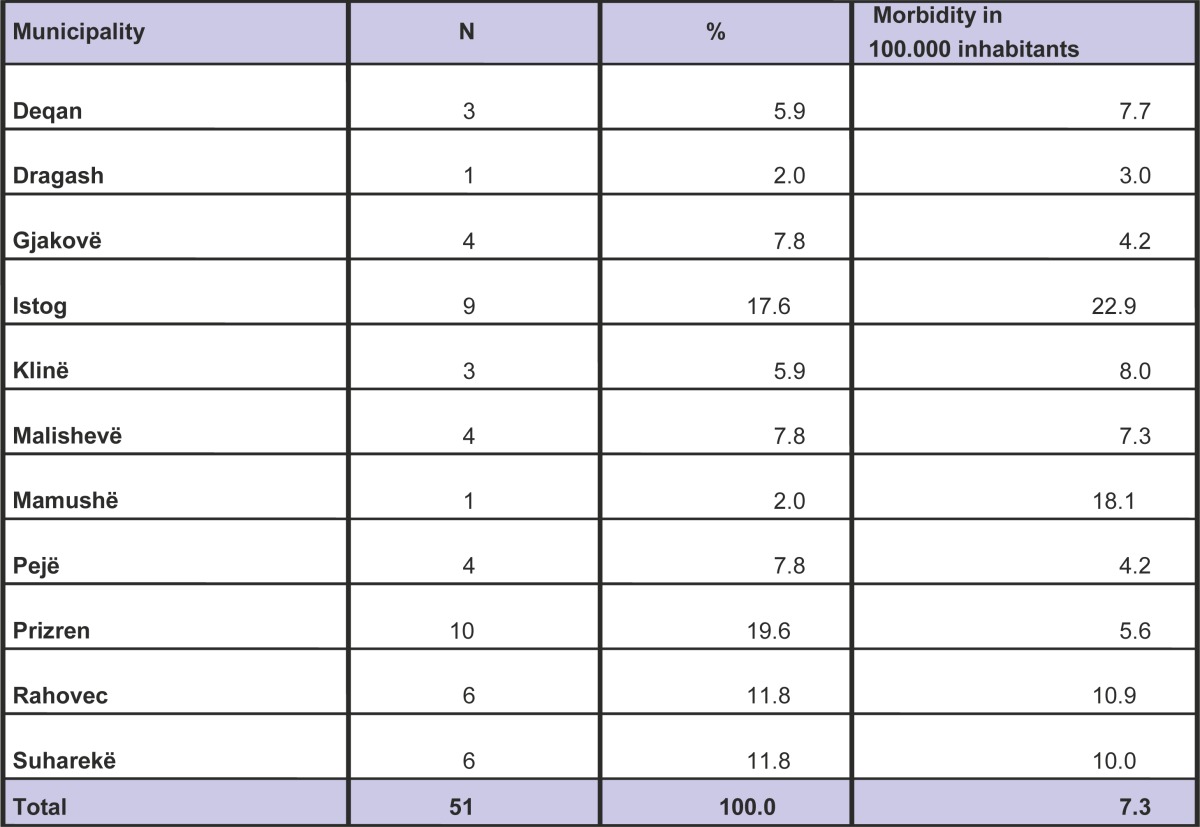 |
Table 3.
Structure of patients disaggregated by municipalities and gender
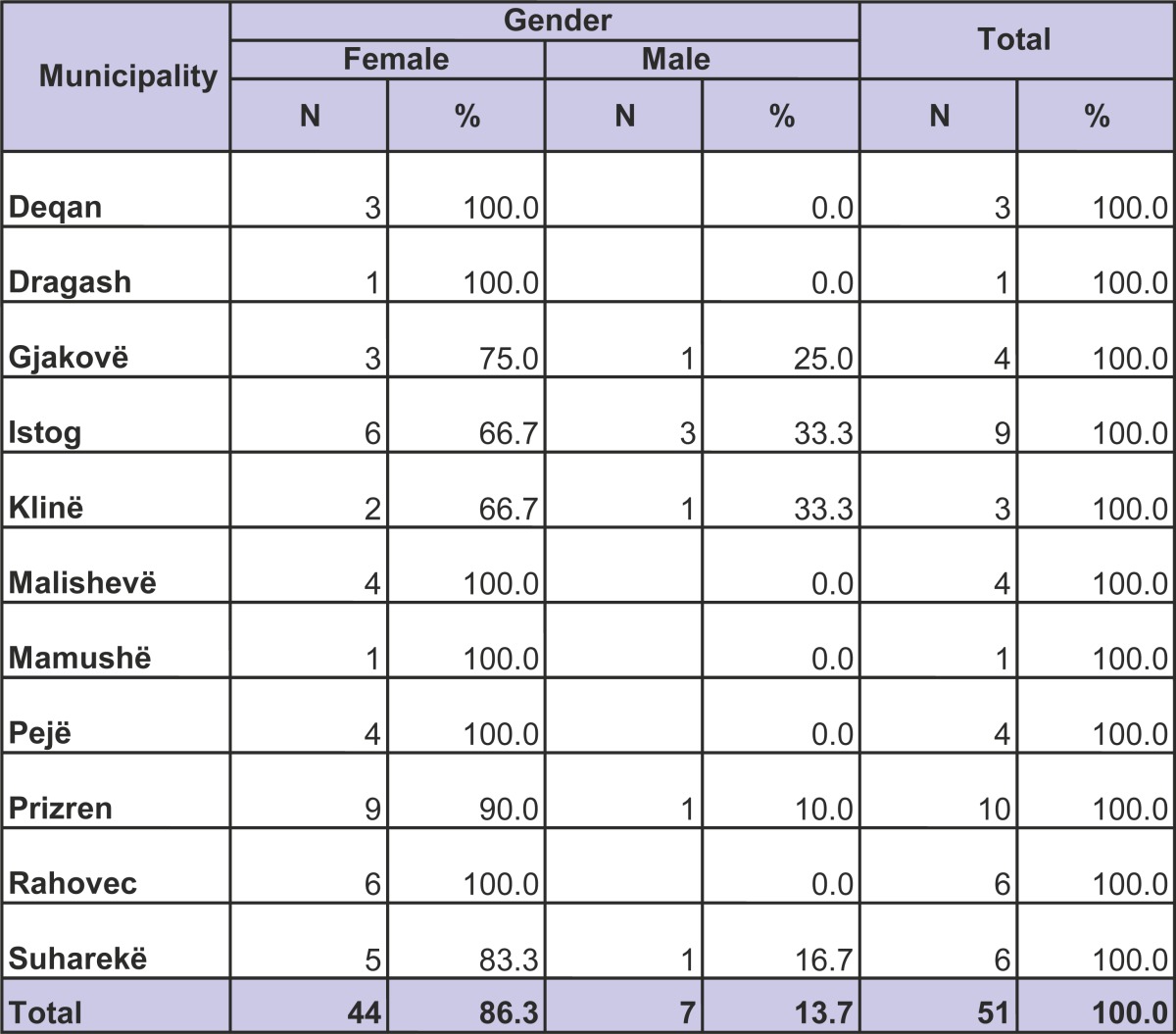 |
Table 4.
The sample gender
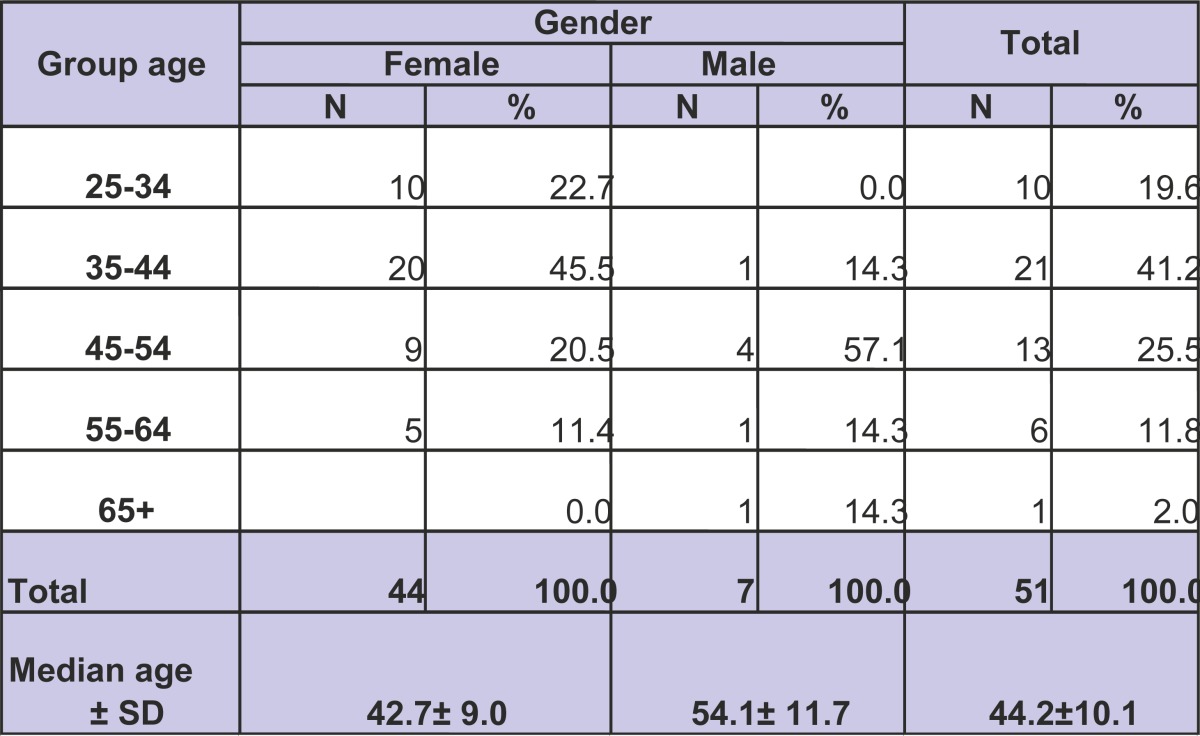 |
Table 5.
ANA ratio of illness chonicity in our sample
 |
Table 6.
Results of laboratory and clinical examination
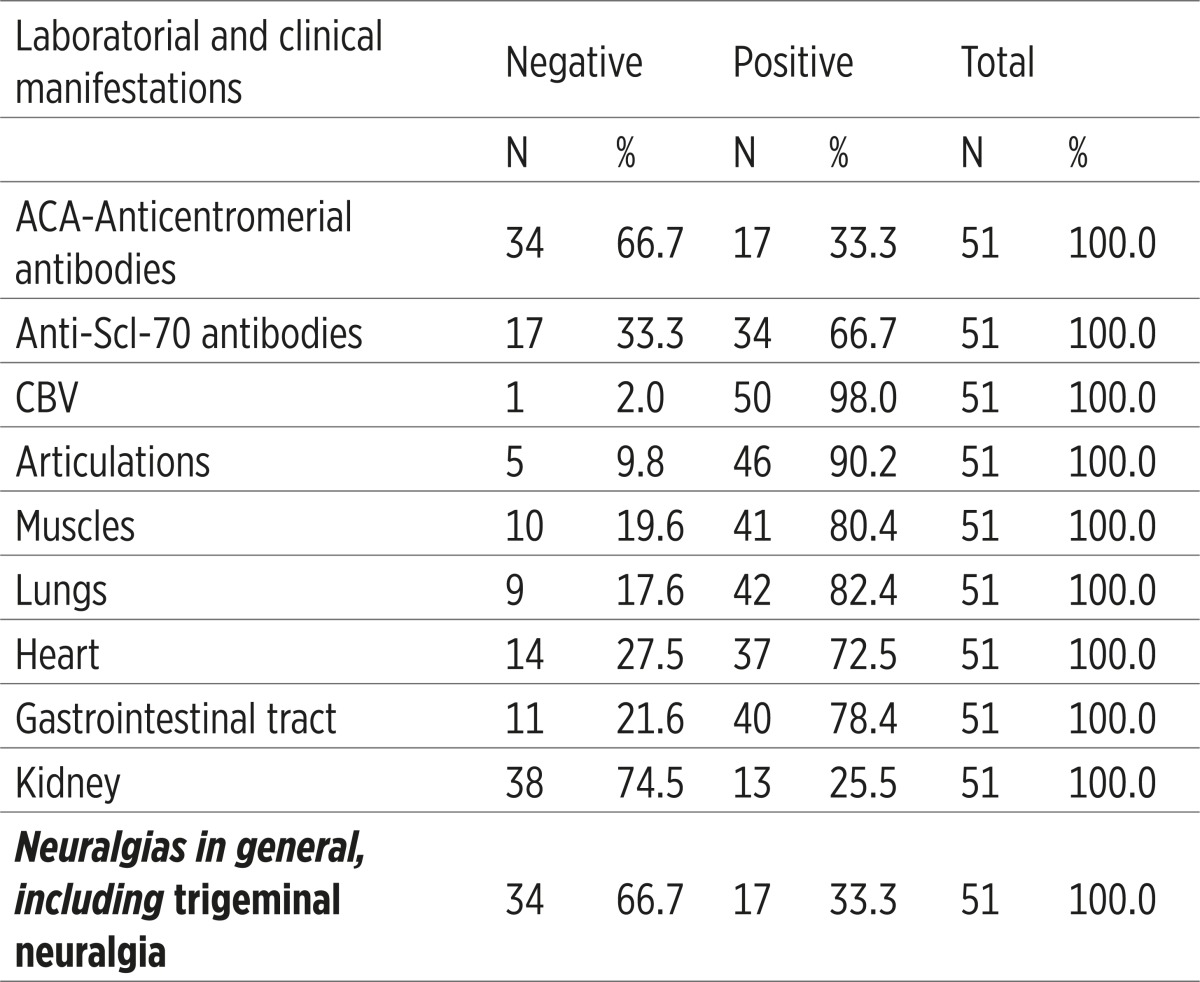 |
Based on the 51 patients – resident citizens of Dukagjini plain, the calculated prevalence is 14.61/100.000 (95%–confidence interval CI), and the annual incidence is the same – 2.8/100.000 cases (C I – 95%). General features of patients, profile of their antibodies, as well as findings in the clinical manifestations are the following. All of our patients come from municipalities of Dukagjini Plain which in the last census revealed this number of population: (Figure 2,3,4,5).
Figure 2.
Structure of patients disaggregated bygender.
Figure 3.
Structure of cases disaggregated by group age.
Figure 4.
Scale of positive ANA results in relation to duration of illnes.
Figure 5.
Level of positive presence of antinuclear antibodies.
Even though Istog municipality is inhabited by 5.8 % of total number of Dukagjini Plain population, it has larger number of patients with PSS. This is the largest prevalence of PSS not only in the Republic of Kosova, but also in Balkan Peninsula, and even wider.
6. DISCUSSION
Several centuries and many years have passed by since 1753, when Italian physician Carlo Curcio described for the first time a 17 year old person with PSS. Interest, researching and treatment of PSS ever since has been always in the focus of scientific and medical community.
In spite of this, PSS is the least explored pathology.
In comparison to known data from completed and published researches, our data are in line with incidence, prevalence, gender, group age, clinical manifestations and antibodies in all municipalities and dwelling places of Dukagjini Plain, with exception of Istog, where the incidence and prevalence have the highest rates in the Republic of Kosova, Balkan Peninsula, and even broader. Patients from Istog municipality have more intense clinical features and course of illness with rapid onset of serious complications in lungs (pulmonary hypertension) and kidneys (sclerotization and renal crises).
During research we have noticed several features that make Istog municipality diff erent from other municipalities in Dukagjini Plain:
Istog is the location with largest number of water and termomineral waters’ resources in Kosova (24).
Nowhere else in Balkan Peninsula winds are more frequent and devastating than in Istog and its vicinity (25).
Inhabitants of this municipality are naturally born beautiful individuals (tall, handsome) and in all beauty pageants (Miss and Mister) give the highest numer of fi nal competitors for both gender – despite the fact this municipality in comparison to overall Kosova population has small number of inhabitants
In this abovementioned quartet of elements: water, air, earth and inheritance we should search for the reasons of incidence and prevalence of PSS among adults in Istog municipality, but other factors as well shall not be overlooked.
We have noticed a slight increase of antibodies against Topoisomerase I Anti SCL-70.
Neuralgias are spotted for the higher occurrence in general, and in particular trigeminal neuralgia’s occurrence among our patients is higher in comparison to data from the literature.
There is a need for a multidisciplinary cohort study for investigating the reasons of asymmetrical occurrence of patients with PSS in Dukagjini Plain, particularly in Istog municipality.
7. CONCLUSION
With this study we have confirmed presence, distribution and clinical manifestations of progressive systemic sclerosis in the Dukagjini Plain.
Highest numbers of patients are from Istog, followed by Mamusha and Rahovec, whereas the lowest numbers of patients come from Dragash.
Incidence and prevalence of PSS in the Dukagjini Plain correspond with the data from literature, with excption of Istog where we have found highest incidence and prevalence (Figure 6).
Figure 6.
Legend C.B.V Acronyme for changes in the blood vessels, including: Raynoud phenomen, finger ulceration, holes on the fingers, skin thickening teleangiectasia. Articular disordes include:synovitis, semi-contractures, contractures and semi-amputacions Muscular disorders:Increased creatin kinase, muscular weakness, muscular atrophy. Lungs:Dyspnea, positive respiratory tests, pulmonary fibrosis in X-ray and CT and pulmonary hypertension Heart:Dyspnea, palpitations, conduction blocks, Diastolok dysfunction, decrased ventricular ejection fraction Digestive system:Esophagus-dysphagia, reflux, vomitus, diarrhea, stomach gurgle, constipation. Kidneys:Hypertension, renal crisis, anemia.
Also other findings in our study related to gender correspond with data from literature. Largest number of cases is in the group age 35-44 year old, followed by the group age 45-54 year old.
All patients are ANA positive, but more frequent are average positive cases. Data for ANA, ACA and anti SCL-70 correspond with literature.
Mostly are affected C.B.V. (in the skin), lungs, digestive tract, the least affected are kidneys.
A slight increase is noticed in neuralgia, particularly of n. trigeminus, which is higher in comparison with literature and other studies.
Additional scientific studies are needed to find out reasons for assymetrical distribution of patients with SPP in the municipalities of Dukagjini Plain, to examine geographical and other factors that have impact in the progressive systemic sclerosis.
Findings on PSS in this study must be compared with findings from the other parts of the Republic of Kosova.
Limitations of the study were: delays in patients’ referrals, objective inabilities to conduct capillaroscopy of patients, several patients were diagnosed abroad and we had a little possibility to follow up their pathology.
Conflict of interest
None declared.
REFERENCES
- 1.Hochberg M, Silman A, Smolen J, Weisman M. Reumatology I-II. 4th edition. Mosby-Elsevier; 2009. [Google Scholar]
- 2.Herrick AL. Vascular function in systemic sclerosis. Curr Opin Rheumatol. 2000;12:527–533. doi: 10.1097/00002281-200011000-00009. [DOI] [PubMed] [Google Scholar]
- 3.Silman AJ. Scleroderma - demographics and survival. J Rheumatol. 1997;24:58–61. [PubMed] [Google Scholar]
- 4.Black CM, Welsh KI. Genetics of scleroderma. Clin Dermatol. 1994;12:337–347. doi: 10.1016/0738-081x(94)90286-0. [DOI] [PubMed] [Google Scholar]
- 5.Arnett FC. HLA and autoimmunity in scleroderma (Systemic sclerosis) Int rev Immunol. 1995;12:107–128. doi: 10.3109/08830189509056707. [DOI] [PubMed] [Google Scholar]
- 6.Jimenez S, Feldman G, Bashey R. Co-ordinate disease in the expression of type II and type III collagen genes in progressive systemic sclerosis fibroblasts. Biochem J. 1986;237:837–843. doi: 10.1042/bj2370837. [DOI] [PMC free article] [PubMed] [Google Scholar]
- 7.Jimenez SA, Derk CT. Following the molecular pathways toward an understading of the pathogenesis of sistemis sclerosis. Ann Intern Med. 2004;140:37–50. [PubMed] [Google Scholar]
- 8.Koenig M, Dieudé M, Senecal JL. Predictor value of antinuclear autoantibadies: the lessons of the systemic sclerosis autoantibadies. Autoimmun Rev. 2008;7:588–593. doi: 10.1016/j.autrev.2008.06.010. [DOI] [PubMed] [Google Scholar]
- 9.Enti i Statistikës së Republikë së Kosovës-regjistrimi i popullsisë
- 10.Altman RD, Medsger TA, Jr, Bloch DA, et al. Predictors of survival in systemic sclerosis (scleroderma) Arthritis Rheum. 1991;34:403–413. doi: 10.1002/art.1780340405. [DOI] [PubMed] [Google Scholar]
- 11.Raynoud M. On local asphyxia and simetrical gangrene of extremities. In: Barlow T, editor. Selected manographs. 121.London: Sudenhaim society; 1888. pp. 1–199. [Google Scholar]
- 12.Albilia JB, Lam DK, Mlanas N, Clokie CM, Sandor GK. Small mouths. Big problems? A review of scleroderma and its oral health implications. J Can Dent Assoc. 2007;73:831–836. [PubMed] [Google Scholar]
- 13.Randone SB, Guidiucci S, Cerinic MM. Musculosceletal involvement in systemic sclerosis . Best Pract Res Clin Rheumatol. 2008;22:339–350. doi: 10.1016/j.berh.2008.01.008. [DOI] [PubMed] [Google Scholar]
- 14.Davidson A, Russel C, Littlejohn GO. Assessment of esophageal abnomalities in progressive systemic sclerosis using radionukleotid transit. J Rheumatol. 1985;12:472–477. [PubMed] [Google Scholar]
- 15.Young MA, Rose S, Reynolds JC. Gastroinestinal manifestation of scleroderma. Rheuma Dis Clin North Am. 1996;22:797–823. doi: 10.1016/s0889-857x(05)70302-1. [DOI] [PubMed] [Google Scholar]
- 16.Silver RM. Clinical problems: the lungs. Rheumatol Dis Clin North Am. 1996;22:865–840. doi: 10.1016/s0889-857x(05)70303-3. [DOI] [PubMed] [Google Scholar]
- 17.Steen VD, Graham D, Conte C, et al. Isolated diffusing capacity reduction in systemic sclerosis. Arthritis Rheum. 1992;35:765–770. doi: 10.1002/art.1780350709. [DOI] [PubMed] [Google Scholar]
- 18. Steen VD, Graham D, Conte C, et al. Isolated diffusing capacity reduction in systemic sclerosis. Arthritis Rheum. 1992;35:765–770. doi: 10.1002/art.1780350709. [DOI] [PubMed] [Google Scholar]
- 19.Belolli L, Carlo-Stella N, Ciocia G, Chiti A, Massorati M, Marasini B. Miocardial involvement in systemic sclerosis. Rheeumatology (Oxford) 2008;47:1070–1072. doi: 10.1093/rheumatology/ken186. [DOI] [PubMed] [Google Scholar]
- 20.Steen VD. Scleroderma renal crisis. Rheum Dis clin North Am. 1996;22:861–876. doi: 10.1016/s0889-857x(05)70305-7. [DOI] [PubMed] [Google Scholar]
- 21.Steen VD, Syzd A, Johnson JP, Greenberg A, Medsger TA., Jr Kidner disease other than renal crisis in patient with diffuse scleroderma. J Rheumatol. 2005;32:649–655. [PubMed] [Google Scholar]
- 22.Valentini G, Della Rossa A, Bombardieri S. The bashpunt Europian multicentre study to define diasease activity criteria for systemic sclerosis. II. Identification of disease activity criteria variables and development of preliminary activity index. Ann Rheum Dis. 2001;60:592–598. doi: 10.1136/ard.60.6.592. [DOI] [PMC free article] [PubMed] [Google Scholar]
- 23.Subcommittee for Scleroderma Criteria of the American Rheumatism Assiciation Diagnostic and Therapeutic Criteria Committee: Preleminary criteria for the classification of systemic sclerosis (scleroderma) Arthritis Rheum. 1980;23:581–590. doi: 10.1002/art.1780230510. [DOI] [PubMed] [Google Scholar]
- 24.www. Google: Istog and district
- 25.The Hidrometeorological Institute of Republic of Kosova



